Development of “New” Bread and Cheese
Abstract
:1. Introduction
2. Development of Gluten-Free Bread
2.1. Conventional Wheat Bread
2.2. Increasing Demand for Gluten-Free Bread
2.3. Development of Additive-Free, Gluten-Free Rice Bread
2.4. Quality Evaluation Studies
2.5. Future Perspectives
2.5.1. Better Communication with Consumers
CATA and ODP
Texture Sensations
Discerning Consumer Attitudes
2.5.2. Boosting Nutritional Benefits
3. Development of Cheese
3.1. History and Aspects of Conventional Cheese
3.2. Demand and Trend for Plant-Based Milk Substitutes
3.2.1. Soy-Based Milk
3.2.2. Almond-Based Milk
3.2.3. Coconut-Based Milk
3.2.4. Oat-Based Milk
3.3. Technologies in Plant-Based Cheese Making
3.4. Fermentation Strategies for Plant-Based Cheese and Outlook
4. Conclusions
Author Contributions
Funding
Conflicts of Interest
References
- Arzani, A. Emmer (Triticum turgidum spp. dicoccum) flour and breads. In Flour and Breads and Their Fortification in Health and Disease Prevention, 1st ed.; Preedy, V.R., Watson, R.R., Patel, V.B., Eds.; Elsevier: Amsterdam, The Netherlands, 2011; Volume 1, pp. 69–78. [Google Scholar]
- Arranz-Otaegui, A.; Carretero, L.G.; Ramsey, M.N.; Fuller, D.Q.; Richter, T. Archaeobotanical evidence reveals the origins of bread 14,400 years ago in northeastern Jordan. Proc. Natl Acad. Sci. USA 2018, 115, 7925–7930. [Google Scholar] [CrossRef] [PubMed] [Green Version]
- McClure, S.B.; Magill, C.; Podrug, E.; Moore, A.M.T.; Harper, T.K.; Culleton, B.J.; Kennett, D.J.; Freeman, K.H. Fatty acid specific δ13C values reveal earliest Mediterranean cheese production 7200 years ago. PLoS ONE 2020, 13, e0202807. [Google Scholar] [CrossRef]
- Silanikove, N.; Leitner, G.; Merin, U. Review: The interrelationships between lactose intolerance and the modern dairy industry: Global perspectives in evolutional and historical backgrounds. Nutrients 2015, 7, 7312–7331. [Google Scholar] [CrossRef] [PubMed] [Green Version]
- Cabanillas, B. Gluten-related disorders: Celiac disease, wheat allergy, and nonceliac gluten sensitivity. Crit. Rev. Food Sci. Nutr. 2020, 60, 2606–2621. [Google Scholar] [CrossRef] [PubMed]
- Rubin, J.E.; Crowe, S.E. Celiac Disease. Ann. Intern. Med. 2020, 172, ITC1–ITC16. [Google Scholar] [CrossRef]
- Tangyu, M.; Muller, J.; Bolten, C.J.; Wittmann, C. Fermentation of plant-based milk alternatives for improved flavour and nutritional value. Appl. Microbiol. Biotechnol. 2019, 103, 9263–9275. [Google Scholar] [CrossRef] [Green Version]
- Oyeyinka, A.T.; Odukoya, J.O.; Adebayo, Y.S. Nutritional composition and consumer acceptability of cheese analog from soy and cashew nut milk. J. Food Process. Preserv. 2019, 43, e14285. [Google Scholar] [CrossRef]
- Yano, H. Recent practical researches in the development of gluten-free breads. NPJ Sci. Food 2019, 3, 7. [Google Scholar] [CrossRef] [Green Version]
- Yano, H.; Fukui, A.; Kajiwara, K.; Kobayashi, I.; Yoza, K.-I.; Satake, A.; Villeneuve, M. Development of gluten-free rice bread: Pickering stabilization as a possible batter-swelling mechanism. LWT Food Sci. Technol. 2017, 79, 632–639. [Google Scholar] [CrossRef]
- Loveday, S.M. Plant protein ingredients with food functionality potential. Nutr. Bull. 2020, 45, 321–327. [Google Scholar] [CrossRef]
- Dobraszczyk, B.J.; Morgenstern, M.P. Review: Rheology and the breadmaking process. J. Cereal Sci. 2003, 38, 229–245. [Google Scholar] [CrossRef]
- Wieser, H. Chemistry of gluten proteins. Food Microbiol. 2007, 24, 115–119. [Google Scholar] [CrossRef] [PubMed]
- Biesiekierski, J.R. What is gluten? J. Gastroenterol. Hepatol. 2017, 32, 78–81. [Google Scholar] [CrossRef] [PubMed] [Green Version]
- Tuhumury, H.C.D.; Small, D.M.; Day, L. The effect of sodium chloride on gluten network formation and rheology. J. Cereal Sci. 2014, 60, 229–237. [Google Scholar] [CrossRef]
- Belz, M.C.E.; Axel, C.; Beauchamp, J.; Zannini, E.; Arendt, E.K.; Czerny, M. Sodium chloride and its influence on the aroma profile of yeasted bread. Foods 2017, 6, 66. [Google Scholar] [CrossRef] [Green Version]
- Wang, Q.; Li, L.; Zheng, X. A review of milling damaged starch: Generation, measurement, functionality and its effect on starch-based food systems. Food Chem. 2020, 315, 126267. [Google Scholar] [CrossRef]
- Protonotariou, S.; Stergiou, P.; Christaki, M.; Mandala, I.G. Physical properties and sensory evaluation of bread containing micronized whole wheat flour. Food Chem. 2020, 318, 126497. [Google Scholar] [CrossRef]
- Ferrand, E.A. Flour properties in relation to the modern bread processes in the United Kingdom with special reference to alpha-amylase and starch damage. Cereal Chem. 1964, 41, 98–111. [Google Scholar]
- Goesaert, H.; Brijs, K.; Veraverbeke, W.S.; Courtin, C.M.; Gebruers, K.; Delcour, J.A. Wheat flour constituents: How they impact bread quality, and how to impact their functionality. Trends Food Sci. Technol. 2005, 16, 12–30. [Google Scholar] [CrossRef]
- Prabhasankar, P.; Haridas Rao, P. Effect of different milling methods on chemical composition of whole wheat flour. Eur. Food Res. Technol. 2001, 213, 465–469. [Google Scholar] [CrossRef]
- Gan, Z.; Angold, R.E.; Williams, M.R.; Ellis, P.R.; Vaughan, J.G.; Galliard, T. The microstructure and gas retention of bread dough. J. Cereal Sci. 1990, 12, 15–24. [Google Scholar] [CrossRef]
- Porres, J.M.; Etcheverry, P.; Miller, D.D.; Lei, X.G. Phytase and citric acid supplementation in whole-wheat bread improves phytate-phosphorus release and iron dialyzability. J. Food Sci. 2001, 66, 614–619. [Google Scholar] [CrossRef]
- Wang, F.C.; Sun, X.S. Thermal expansion of flour-water dough measured with a dynamic mechanical analyzer. Cereal Chem. 1999, 76, 87–91. [Google Scholar] [CrossRef]
- Kusunose, C.; Fujii, T.; Matsumoto, H. Role of starch granules in controlling expansion of dough during baking. Cereal Chem. 1999, 76, 920–924. [Google Scholar] [CrossRef]
- Pico, J.; Bernal, J.; Gómez, M. Wheat bread aroma compounds in crumb and crust: A review. Food Res. Int. 2015, 75, 200–215. [Google Scholar] [CrossRef]
- Helou, C.; Jacolot, P.; Niquet-Léridon, C.; Gadonna-Widehem, P.; Tessier, F.J. Maillard reaction products in bread: A novel semi-quantitative method for evaluating melanoidins in bread. Food Chem. 2016, 190, 904–911. [Google Scholar] [CrossRef]
- Cianferoni, A. Wheat allergy: Diagnosis and management. J. Asthma Allergy 2016, 9, 13–25. [Google Scholar] [CrossRef] [PubMed] [Green Version]
- Gatti, S.; Lionetti, E.; Balanzoni, L.; Verma, A.K.; Galeazzi, T.; Gesuita, R.; Scattolo, N.; Cinquetti, M.; Fasano, A.; Catassi, C. Increased prevalence of celiac disease in school-age children in Italy. Clin. Gastroenterol. Hepatol. 2020, 18, 596–603. [Google Scholar] [CrossRef] [PubMed]
- Gluten-Free Products Market Size Worth $43.65 Billion by 2027. Available online: https://www.grandviewresearch.com/press-release/global-gluten-free-products-market (accessed on 28 October 2020).
- Juhász, A.; Colgrave, M.L.; Howitt, C.A. Developing gluten-free cereals and the role of proteomics in product safety. J. Cereal Sci. 2020, 93, e102932. [Google Scholar] [CrossRef]
- Bender, D.; Schönlechner, R. Innovative approaches towards improved gluten-free bread properties. J. Cereal Sci. 2020, e102904. [Google Scholar] [CrossRef]
- Moroni, A.V.; Dal Bello, F.; Arendt, E.K. Sourdough in gluten free bread making: An ancient technology to solve a novel issue? Food Microbiol. 2009, 26, 676–684. [Google Scholar] [CrossRef] [PubMed]
- Jansen, T.; Claassen, L.; Van Kamp, I.; Timmermans, D.R.M. ‘All chemical substances are harmful.’ public appraisal of uncertain risks of food additives and contaminants. Food Chem. Toxicol. 2020, 136, e110959. [Google Scholar] [CrossRef] [PubMed]
- Denkov, N.; Tcholakova, S.; Politova-Brinkova, N. Physicochemical control of foam properties. Curr. Opin. Colloid Interface Sci. 2020. [Google Scholar] [CrossRef]
- Li, C.; Li, Y.; Sun, P.; Yang, C. Pickering emulsions stabilized by native starch granules. Colloid Surf. A Physicochem. Eng. Asp. 2013, 431, 142–149. [Google Scholar] [CrossRef]
- Dickinson, E. Advances in food emulsions and foams: Reflections on research in the neo-Pickering era. Curr. Opin. Food Sci. 2020, 33, 52–60. [Google Scholar] [CrossRef]
- Wu, T.; Wang, L.; Li, Y.; Qian, H.; Liu, L.; Tong, L.; Zhou, X.; Wang, L.; Zhou, S. Effect of milling methods on the properties of rice flour and gluten-free rice bread. LWT Food Sci. Technol. 2019, 108, 137–144. [Google Scholar] [CrossRef]
- Kokini, J.; Van Aken, G. Discussion session on food emulsions and foams. Food Hydrocoll. 2006, 20, 438–445. [Google Scholar] [CrossRef]
- Van Duynhoven, J.P.M.; Van Kempen, G.M.P.; Van Sluis, R.; Rieger, B.; Weegels, P.; Van Vliet, L.J.; Nicolay, K. Quantitative assessment of gas cell development during the proofing of dough by magnetic resonance imaging and image analysis. Cereal Chem. 2003, 80, 390–395. [Google Scholar] [CrossRef] [Green Version]
- Turbin-Orger, A.; Boller, E.; Chaunier, L.; Chiron, H.; Della Valle, G.; Reguerre, A.-L. Kinetics of bubble growth in wheat flour dough during proofing studied by computed X-ray micro-tomography. J. Cereal Sci. 2012, 56, 676–683. [Google Scholar] [CrossRef]
- A New Method of Making Rice Flour Bread—No Addition of Wheat Flour or Gluten. Available online: https://www.youtube.com/watch?v=O0_MJeb2Qv4 (accessed on 21 October 2020).
- Wada’s Rice Bread. Available online: https://en.naturalfood.jp/ (accessed on 21 October 2020).
- Hayakawa, F.; Kazami, Y.; Sekiyama, Y.; Yano, H. Quality evaluation study on the gluten-free rice breads. Bull. NARO Food Res. 2019, 3, 9–17. (In Japanese) [Google Scholar] [CrossRef]
- Valentin, D.; Chollet, S.; Lelievre, M.; Abdi, H. Quick and dirty but still pretty good: A review of new descriptive methods in food science. Int. J. Food Sci. Technol. 2012, 47, 15631578. [Google Scholar] [CrossRef]
- Aoki, N.; Kataoka, T.; Nishiba, Y. Crucial role of amylose in the rising of gluten-and additive-free rice bread. J. Cereal Sci. 2020, 92, e102905. [Google Scholar] [CrossRef]
- Roman, L.; Belorio, M.; Gomez, M. Gluten-free breads: The gap between research and commercial reality. Compr. Rev. Food Sci. Food Saf. 2019, 18, 690–702. [Google Scholar] [CrossRef] [Green Version]
- Guiné, R.P.F.; Florença, S.G.; Barroca, M.J.; Anjos, O. The link between the consumer and the innovations in food product development. Foods 2020, 9, 1317. [Google Scholar] [CrossRef] [PubMed]
- Aguiar, L.A.; Rodrigues, D.B.; Queiroz, V.A.V.; Melo, L.; Pineli, L.L.O. Comparison of two rapid descriptive sensory techniques for profiling and screening of drivers of liking of sorghum breads. Food Res. Int. 2020, 131, 108999. [Google Scholar] [CrossRef]
- De Cassia dos SantosNavarro da Silva, R.; Minim, V.P.R.; Simiqueli, A.A.; Da Silva Moraes, L.E.; Gomide, A.I.; Minim, L.A. Optimized Descriptive Profile: A rapid methodology for sensory description. Food Qual. Prefer. 2012, 24, 190–200. [Google Scholar] [CrossRef]
- Hayward, L.; McSweeney, M.B. Acceptability of bread made with hemp (Cannabis sativa subsp. sativa) flour evaluated fresh and following a partial bake method. J. Food Sci. 2020. [Google Scholar] [CrossRef]
- Cunha, L.M.; Fonseca, S.C.; Lima, R.C.; Loureiro, J.; Pinto, A.S.; Vaz Patto, M.C.; Brites, C. Consumer-driven improvement of maize bread formulations with legume fortification. Foods 2019, 8, 235. [Google Scholar] [CrossRef] [Green Version]
- Cardillo Diniz, R.; Morcatti Coura, F.; Ferreira Rodrigues, J. Effect of different gluten-free flours on the sensory characteristics of a vegan alfajor: Vegan gluten-free Alfajor development. Food Sci. Technol. Int. 2020. [Google Scholar] [CrossRef]
- Cannas, M.; Pulina, S.; Conte, P.; Del Caro, A.; Urgeghe, P.P.; Piga, A.; Fadda, C. Effect of substitution of rice flour with Quinoa flour on the chemical-physical, nutritional, volatile and sensory parameters of gluten-free ladyfinger biscuits. Foods 2020, 9, 808. [Google Scholar] [CrossRef]
- Xu, J.; Zhang, Y.; Wang, W.; Li, Y. Advanced properties of gluten-free cookies, cakes, and crackers: A review. Trends Food Sci. Technol. 2020, 103, 200–213. [Google Scholar] [CrossRef]
- Van Eck, A.; Stieger, M. Oral processing behavior, sensory perception and intake of composite foods. Trends Food Sci. Technol. 2020, 106, 219–231. [Google Scholar] [CrossRef]
- Puerta, P.; Laguna, L.; Villegas, B.; Rizo, A.; Fiszman, S.; Tarrega, A. Oral processing and dynamics of texture perception in commercial gluten free breads. Food Res. Int. 2020, 134, 109233–109243. [Google Scholar] [CrossRef] [PubMed]
- Panda, S.; Chen, J.; Benjamin, O. Development of model mouth for food oral processing studies: Present challenges and scopes. Innov. Food Sci. Emerg. Technol. 2020. [Google Scholar] [CrossRef]
- Witt, T.; Stokes, J.R. Physics of food structure breakdown and bolus formation during oral processing of hard and soft solids. Curr. Opin. Food Sci. 2015, 3, 110–117. [Google Scholar] [CrossRef] [Green Version]
- Pu, D.; Duan, W.; Huang, Y.; Zhang, L.; Zhang, Y.; Sun, B.; Ren, F.; Zhang, H.; Tang, Y. Characterization of the dynamic texture perception and the impact factors on the bolus texture changes during oral processing. Food Chem. 2021, 339, 128078. [Google Scholar] [CrossRef]
- Kohyama, K.; Ishihara, S.; Nakauma, M.; Funami, T. Fracture phenomena of soft gellan gum gels during compression with artificial tongues. Food Hydrocoll. 2021, 112, 106283. [Google Scholar] [CrossRef]
- Puerta, P.; Laguna, L.; Vidal, L.; Ares, G.; Fiszman, S.; Tárrega, A. Co-occurrence networks of Twitter content after manual or automatic processing. A case-study on “gluten-free”. Food Qual. Prefer. 2020, 86, 103993. [Google Scholar] [CrossRef]
- Sielicka-Różyńska, M.; Jerzyk, E.; Gluza, N. Consumer perception of packaging: An eye-tracking study of gluten-free cookies. Int. J. Consum. Stud. 2020. [Google Scholar] [CrossRef]
- Fajardo, V.; González, M.P.; Martínez, M.; Samaniego-Vaesken, M.L.; Achón, M.; Úbeda, N.; Alonso-Aperte, E. Updated food composition database for cereal-based gluten free products in Spain: Is reformulation moving on? Nutrients 2020, 12, 2369. [Google Scholar] [CrossRef]
- Kreutz, J.M.; Adriaanse, M.P.M.; Van der Ploeg, E.M.C.; Vreugdenhil, A.C.E. Narrative review: Nutrient deficiencies in adults and children with treated and untreated celiac disease. Nutrients 2020, 12, 500. [Google Scholar] [CrossRef] [PubMed] [Green Version]
- Demirkesen, I.; Ozkaya, B. Recent strategies for tackling the problems in gluten-free diet and products. Crit. Rev. Food Sci. Nutr. 2020, 28, 1–27. [Google Scholar] [CrossRef] [PubMed]
- Di Nardo, G.; Villa, M.P.; Conti, L.; Ranucci, G.; Pacchiarotti, C.; Principessa, L.; Raucci, U.; Parisi, P. Nutritional deficiencies in children with celiac disease resulting from a gluten-free diet: A systematic review. Nutrients 2019, 11, 1588. [Google Scholar] [CrossRef] [PubMed] [Green Version]
- Bourekoua, H.; Gawlik-Dziki, U.; Różyło, R.; Zidoune, M.N.; Dziki, D. Acerola fruit as a natural antioxidant ingredient for gluten-free bread: An approach to improve bread quality. Food Sci. Technol. Int. 2020. [Google Scholar] [CrossRef]
- Beltrão Martins, R.; Gouvinhas, I.; Nunes, M.C.; Alcides Peres, J.; Raymundo, A.; Barros, A.I. Acorn flour as a source of bioactive compounds in gluten-free bread. Molecules 2020, 25, 3568. [Google Scholar] [CrossRef]
- Conte, P.; Del Caro, A.; Urgeghe, P.P.; Petretto, G.L.; Montanari, L.; Piga, A.; Fadda, C. Nutritional and aroma improvement of gluten-free bread: Is bee pollen effective? LWT Food Sci. Technol. 2020, 118, 108711. [Google Scholar] [CrossRef]
- Zdybel, B.; Różyło, R.; Sagan, A. Use of a waste product from the pressing of chia seed oil in wheat and gluten-free bread processing. J. Food Process. Preserv. 2020, 43, e14002. [Google Scholar] [CrossRef]
- Diprat, A.B.; Thys, R.C.S.; Rodrigues, E.; Rech, R. Chlorella sorokiniana: A new alternative source of carotenoids and proteins for gluten-free bread. LWT Food Sci. Technol. 2020, 134, 109974. [Google Scholar] [CrossRef]
- Rios, M.B.; Iriondo-DeHond, A.; Iriondo-DeHond, M.; Herrera, T.; Velasco, D.; Gómez-Alonso, S.; Callejo, M.J.; Del Castillo, M.D. Effect of coffee cascara dietary fiber on the physicochemical, nutritional and sensory properties of a gluten-free bread formulation. Molecules 2020, 25, 1358. [Google Scholar] [CrossRef] [Green Version]
- Nissen, L.; Samaei, S.P.; Babini, E.; Gianotti, A. Gluten free sourdough bread enriched with cricket flour for protein fortification: Antioxidant improvement and volatilome characterization. Food Chem. 2020, 333, 127410. [Google Scholar] [CrossRef]
- Graça, C.; Raymundo, A.; Sousa, I. Improving the technological and nutritive properties of gluten-free bread by fresh curd cheese enrichment. Appl. Sci. 2020, 10, 6868. [Google Scholar] [CrossRef]
- Haber, M.; Mishyna, M.; Martinez, J.J.I.; Benjamin, O. The influence of grasshopper (Schistocerca gregaria) powder enrichment on bread nutritional and sensorial properties. LWT Food Sci. Technol. 2019, 115, 108395. [Google Scholar] [CrossRef]
- Khemiri, S.; Khelifi, N.; Nunes, M.C.; Ferreira, A.; Gouveia, L.; Smaali, I.; Raymundo, A. Microalgae biomass as an additional ingredient of gluten-free bread: Dough rheology, texture quality and nutritional properties. Algal Res. 2020, 50, 101998. [Google Scholar] [CrossRef]
- Martínez-Castaño, M.; Lopera-Idarraga, J.; Pazmiño-Arteaga, J.; Gallardo-Cabrera, C. Evaluation of the behavior of unripe banana flour with non-conventional flours in the production of gluten-free bread. Food Sci. Technol. Int. 2020, 26, 160–172. [Google Scholar] [CrossRef]
- Graça, C.; Raymundo, A.; Sousa, I. Yogurt as an alternative ingredient to improve the functional and nutritional properties of gluten-free breads. Foods 2020, 9, 111. [Google Scholar] [CrossRef] [PubMed] [Green Version]
- Arslan, M.; Rakha, A.; Xiaobo, Z.; Mahmood, M.A. Complimenting gluten free bakery products with dietary fiber: Opportunities and constraints. Trends Food Sci. Technol. 2019, 83, 194–202. [Google Scholar] [CrossRef]
- Gravel, A.; Doyen, A. The use of edible insect proteins in food: Challenges and issues related to their functional properties. Innov. Food Sci. Emerg. Technol. 2020, 59, 102272. [Google Scholar] [CrossRef]
- Melini, F.; Melini, V.; Luziatelli, F.; Ruzzi, M. Current and forward-looking approaches to technological and nutritional improvements of gluten-free bread with legume flours: A critical review. Compr. Rev. Food Sci. Food Saf. 2017, 16, 1101–1122. [Google Scholar] [CrossRef]
- Mintah, B.K.; He, R.; Agyekum, A.A.; Dabbour, M.; Golly, M.K.; Ma, H. Edible insect protein for food applications: Extraction, composition, and functional properties. J. Food Process. Eng. 2020, 43, e13362. [Google Scholar] [CrossRef]
- Mishyna, M.; Chen, J.; Benjamin, O. Sensory attributes of edible insects and insect-based foods – Future outlooks for enhancing consumer appeal. Trends Food Sci. Technol. 2020, 95, 141–148. [Google Scholar] [CrossRef]
- De Gier, S.; Verhoeckx, K. Insect (food) allergy and allergens. Mol. Immunol. 2018, 100, 82–106. [Google Scholar] [CrossRef] [PubMed]
- History of Cheese. Available online: https://davemurat.wordpress.com/history-of-cheese/ (accessed on 26 October 2020).
- The History of Cheese. Available online: https://www.thespruceeats.com/the-history-of-cheese-1328765 (accessed on 26 October 2020).
- Lucey, J.A.; Johnson, M.E.; Horne, D.S. Perspectives on the basis of the rheology and texture properties of cheese. J. Dairy Sci. 2003, 86, 2725–2743. [Google Scholar] [CrossRef] [Green Version]
- Processed Cheese. Available online: https://en.wikipedia.org/wiki/Processed_cheese (accessed on 26 October 2020).
- Wei, F.; Yurika, W.; Hayaka, S.; Keita, I.; Natsumi, M.; Kazunao, F.; Yuya, Y.; Takaaki, M.; Takashi, N. Effects of emulsifying conditions on creaming effect, mechanical properties and microstructure of processed cheese using a rapid visco-analyzer. Biosci. Biotechnol. Biochem. 2018, 82, 476–483. [Google Scholar]
- Wei, F.; Takashi, N. Effects of starches on the mechanical properties and microstructure of processed cheeses with different types of casein network structures. Food Hydrocoll. 2018, 79, 587–595. [Google Scholar]
- Keita, I.; Wei, F.; Takashi, N. Explaining the different textures of commercial processed cheese from fractured structures. Int. Dairy J. 2019, 97, 40–48. [Google Scholar]
- Wei, F.; Takashi, N. Moisture content impact creaming effect and microstructure of processed cheese containing different textural starches. Int. Dairy J. 2020, 105, 104685. [Google Scholar]
- Lucey, J.A. Formation and physical properties of milk protein gels. J Dairy Sci. 2002, 85, 281–294. [Google Scholar] [CrossRef]
- Casein. Available online: https://en.wikipedia.org/wiki/Casein (accessed on 26 October 2020).
- Bennett, R.J.; Trivedi, D.; Hemar, Y.; Reid, D.C.W.; Illingworth, D.; Lee, S.K. The effect of starch addition on the rheological and microstructural properties of model processed cheese. Aust. J. Dairy Technol. 2006, 61, 157–159. [Google Scholar]
- Kawasaki, Y. Influence of “creaming” on the properties of processed cheese and changes in the structure of casein during cheese making. Milchwiss. Milk Sci. Int. 2008, 63, 149–152. [Google Scholar]
- Wei, F.; Yurika, W.; Keita, I.; Natsumi, M.; Kazunao, F.; Yuya, Y.; Takaaki, M.; Takashi, N. Effects of pre-cooked cheeses of different emulsifying conditions on mechanical properties and microstructure of processed cheese. Food Chem. 2018, 245, 47–52. [Google Scholar]
- Noronha, N.; O’Riordan, E.D.; O’Sullivan, M. Influence of processing parameters on the texture and microstructure of imitation cheese. Eur. Food Res. Technol. 2008, 226, 385–393. [Google Scholar] [CrossRef]
- Shirashoji, N.; Jaeggi, J.J. Effect of trisodium citrate concentration and cooking time on the physicochemical properties of pasteurized process cheese. J. Dairy Sci. 2006, 89, 15–28. [Google Scholar] [CrossRef]
- Gupta, S.K.; Karahadian, C.; Lindsay, R.C. Effect of emulsifier salts on textural and flavor properties of processed cheese. J. Dairy Sci. 1984, 67, 764–778. [Google Scholar] [CrossRef]
- Lu, Y.; Shirashoji, N.; Lucey, J.A. Effects of pH on the textural properties and meltability of pasteurized process cheese made with different types of emulsifying salts. J. Food Sci. 2008, 73, E363–E369. [Google Scholar] [CrossRef] [PubMed]
- Shirashoji, N.; Jaeggi, J.J.; Lucey, J.A. Effect of sodium hexametaphosphate concentration and cooking time on the physicochemical properties of pasteurized process cheese. J. Dairy Sci. 2010, 93, 2827–2837. [Google Scholar] [CrossRef] [Green Version]
- Bunka, F.; Doudova, L.; Weiserova, E.; Kuchar, D.; Michalek, J.; Slavikova, S.; Kracmar, S. The effect of different ternary mixtures of sodium phosphates on the hardness of processed cheese spreads. Int. J. Food Sci. Technol. 2012, 47, 2063–2071. [Google Scholar] [CrossRef]
- Hougaard, A.B.; Sijbrandij, A.G.; Varming, C.; Ardo, Y.; Ipsen, R. Emulsifying salt increase stability of cheese emulsions during holding. LWT Food Sci. Technol. 2015, 62, 362–365. [Google Scholar] [CrossRef]
- Dimitreli, G.; Thomareis, A.S. Instrumental textural and viscoelastic properties of processed cheese as affected by emulsifying salts and in relation to its apparent viscosity. Int. J. Food Prop. 2009, 12, 261–275. [Google Scholar] [CrossRef]
- Weiserova, E.; Doudova, L.; Galiova, L.; Zak, L.; Michalek, J.; Janis, R.; Bunka, F. The effect of combinations of sodium phosphates in binary mixtures on selected texture parameters of processed cheese spreads. Int. Dairy J. 2011, 21, 979–986. [Google Scholar] [CrossRef]
- Mizuno, R.; Lucey, J.A. Properties of milk protein gel formed by phosphates. J. Dairy Sci. 2007, 90, 4524–4531. [Google Scholar] [CrossRef]
- Guinee, T.P. Salting and the role of salt in cheese. Int. J. Dairy Technol. 2004, 57, 99–109. [Google Scholar] [CrossRef]
- Elmadfa, I.; Freisling, H. Food-based dietary guidelines in Austria. Ann. Nutr. Metab. 2007, 51, 8–14. [Google Scholar] [CrossRef]
- Vanga, S.K.; Raghavan, V. How well do plant based alternatives fare nutritionally compared to cow’s milk. J. Food Sci. Technol. 2018, 55, 10–20. [Google Scholar] [CrossRef] [PubMed]
- OECD-FAO Agricultural Outlook 2020–2029. Available online: https://www.oecd-ilibrary.org/agriculture-and-food/oecd-fao-agricultural-outlook-2020-2029_1112c23b-en (accessed on 26 October 2020).
- Kundu, P.; Dhankhar, J.; Sharma, A. Development of non dairy milk alternative using soymilk and almond milk. Curr. Res. Nutr. Food Sci. 2018, 6, 203–210. [Google Scholar] [CrossRef]
- Haas, R.; Schnepps, A.; Pichler, A.; Meixner, O. Cow milk versus plant-based milk substitutes: A comparison of product image and motivational structure of consumption. Sustainability 2019, 11, 5046. [Google Scholar] [CrossRef] [Green Version]
- Makinen, O.E.; Wanhalinna, V.; Zannini, E.; Arendt, E.K. Foods for special dietary needs: Non-dairy plant-based milk substitutes and fermented dairy-type products. Crit. Rev. Food Sci. Nutr. 2016, 56, 339–349. [Google Scholar] [CrossRef]
- U.S. Plant-Based Retail Market Worth $5 Billion, Growing at 5X Total Food Sales. Available online: https://plantbasedfoods.org/plant-based-foods-retail-sales-data-2020/ (accessed on 26 October 2020).
- Jeske, S.; Zannini, E.; Arendt, E.K. Evaluation of physicochemical and glycaemic properties of commercial plant-based milk substitutes. Plant Foods Hum. Nutr. 2017, 72, 26–33. [Google Scholar] [CrossRef] [Green Version]
- Sethi, S.; Tyagi, S.K.; Anurag, R.K. Plant-based milk alternatives an emerging segment of functional beverages: A review. J. Food Sci. Technol. 2016, 53, 3408–3423. [Google Scholar] [CrossRef]
- Silva, A.R.A.; Silva, M.M.N.; Ribeiro, B.D. Health issues and technological aspects of plant-based alternative milk. Food Res. Int. 2020, 131, 108972. [Google Scholar] [CrossRef]
- McClements, D.J.; Newman, E.; McClements, I.F. Plant-based milks: A review of the science underpinning their design, fabrication, and performance. Compr. Rev. Food Sci. Food Saf. 2019, 18, 2047–2067. [Google Scholar] [CrossRef] [Green Version]
- Bisla, G.; Verma, A.; Verma, P.; Sharma, S. Development of ice creams from soybean milk and watermelon seeds milk and evaluation of their acceptability and nourishing potential. Adv. Appl. Sci. Res. 2012, 3, 371–376. [Google Scholar]
- Nande, P.; Tapadia, P.; Jain, K.; Lodhaya, F.; Vali, S.A. A study on soy milk as a substitute for animal milk. J. Dairy Foods Home Sci. 2008, 27, 1–10. [Google Scholar]
- Joo, S.I.; Kim, J.E.; Lee, S.P. Physicochemical properties of whole soybean curd prepared by microbial transglutaminase. Food Sci. Biotechnol. 2011, 20, 437–444. [Google Scholar] [CrossRef]
- Dhakal, S.; Liu, C.; Zhang, Y.; Roux, K.H.; Sathe, S.K.; Balasubramaniam, V.M. Effect of high pressure processing on the immunore-actibity of almond milk. Food Res. Int. 2014, 62, 215–222. [Google Scholar] [CrossRef]
- Roncero, J.M.; Alvarez-Orti, M.; Pardo-Gimenez, A.; Gomez, R.; Rabadan, A.; Pardo, J.E. Virgin almond oil: Extraction methods and composition. Grasas Aceites 2016, 67, e143. [Google Scholar]
- Maria, M.F.; Victoria, A.T. Influence of processing treatments on quality of vegetable milk from almond (Terminalia catappa) kernels. Acta Sci. Nutr. Health 2018, 2, 37–42. [Google Scholar]
- Burton, G.W.; Ingold, K.U. Vitamin E as an in vitro and in vivo antioxidant. Ann. N. Y. Acad. Sci. 1989, 570, 7–22. [Google Scholar] [CrossRef]
- Seow, C.C.; Gwee, C.N. Coconut milk: Chemistry and technology. Int. J. Food Sci. Technol. 1997, 32, 189–201. [Google Scholar] [CrossRef]
- Ekanayaka, R.; Ekanayaka, N.; Perera, B.; De Silva, P. Impact of a traditional dietary supplement with coconut milk and soya milk on the lipid profile in normal free living subjects. J. Nutr. Metab. 2013, 2013, 481068. [Google Scholar] [CrossRef] [Green Version]
- Tinchan, P.; Lorjaroenphon, Y.; Cadwallader, K.R.; Chaiseri, S. Changes in the profile of volatiles of canned coconut milk during storage. J. Food Sci. 2015, 80, C49–C54. [Google Scholar] [CrossRef]
- Truswell, A.S. Cereal grains and coronary heart disease. Eur. J. Clin. Nutr. 2002, 56, 1–14. [Google Scholar] [CrossRef] [PubMed] [Green Version]
- Deswal, A.; Deora, N.S.; Mishra, H.N. Optimization of enzymatic production process of oat milk using response surface methodology. Food Bioprocess Technol. 2014, 7, 610–618. [Google Scholar] [CrossRef]
- Rasane, P.; Jha, A.; Sabikhi, L.; Kumar, A.; Unnikrishnan, V.S. Nutritional advantages of oats and opportunities for its processing as value added foods—A review. J. Food Sci. Technol. 2013, 52, 662–675. [Google Scholar] [CrossRef] [PubMed] [Green Version]
- Bachmann, H.P. Cheese analogues: A review. Int. Dairy J. 2001, 11, 505–515. [Google Scholar] [CrossRef]
- Li, Q.; Xia, Y.; Zhou, L.; Xie, J. Eveluation of the rheological, textural, microstructural and sensory properties of soy cheese spreads. Food Bioproducts Process. 2013, 91, 429–439. [Google Scholar] [CrossRef]
- Aoyama, M.; Yasuda, M.; Nakachi, K.; Kobamoto, N.; Oku, H.; Kato, F. Soybean-milk-coagulating activity of Bacillus pumilus derives from a serine proteinase. Appl. Microbiol. Biotechnol. 2000, 53, 390–395. [Google Scholar] [CrossRef]
- Inouye, K.; Nagai, K.; Takita, T. Coagulation of soy protein isolates induced by subtilisin Carlsberg. J. Agric. Food Chem. 2002, 50, 1237–1242. [Google Scholar] [CrossRef]
- Santos, B.L.; Resurreccion, A.V.; Garcia, V.V. Quality characteristics and consumer acceptance of a peanut-based imitation cheese spread. J. Food Sci. 1989, 54, 468. [Google Scholar] [CrossRef]
- Kohyama, K.; Nishinari, K. Rheological studies on the gelation process of soybean 7 S and 11 S proteins in the presence of glucono-delta-lactone. J. Agric. Food Chem. 1993, 41, 8–14. [Google Scholar] [CrossRef]
- Rani, M.; Verma, N. Changes in organoleptic quality during ripening of cheese made from cows and soya milk blends, using microbial rennet. Food Chem. 1995, 54, 369–375. [Google Scholar] [CrossRef]
- Watanabe, Y.; Sekiguchi, M.; Matsuoka, H. Curd formation by rennet from soymilk combined with bovine milk and its ripening. Nippon Shokuhin Kagaku Kogaku Kaishi 2004, 51, 449–455. [Google Scholar] [CrossRef]
- Chavan, R.S.; Jana, A. Cheese substitutes: An alternative to natural cheese—A review. Int. J. Food Sci. Technol. Nutr. 2007, 2, 25–39. [Google Scholar]
- Lobato-Calleros, C.; Vernon-Carter, E.J.; Guerrero-Legarreta, I.; Soriano-Santos, J.; Escalona-Beundia, H. Use of fat blends in cheese analogs: Influence on sensory and instrumental textural characteristics. J. Texture Stud. 1997, 28, 619–632. [Google Scholar] [CrossRef]
- Mozaffarian, D.; Clarke, R. Quantitative effects on cardiovascular risk factors and coronary heart disease risk of replacing partially hydrogenated vegetable oils with other fats and oils. Eur. J. Clinical Nutr. 2009, 63, S22–S33. [Google Scholar] [CrossRef] [PubMed] [Green Version]
- Zulkurmain, M.; Goh, M.H.; Karim, A.A.; Liong, M.T. Development of a soy-based cream cheese. J. Texture Stud. 2008, 39, 635–654. [Google Scholar] [CrossRef]
- Fox, P.F.; Guinee, T.P.; Cogan, T.M.; McSweeney, P.L.H. Processed cheese and substitute/imitation cheese products. In Fundamentals of Cheese Science; Springer: Berlin, Germany, 2017; pp. 589–628. [Google Scholar]
- Mattice, K.D.; Marangoni, A.G. Physical properties of plant-based cheese products produced with zein. Food Hydrocoll. 2020, 105, 105746. [Google Scholar] [CrossRef]
- Jeske, S.; Zannini, E.; Arendt, E.K. Past, present and future: The strength of plant-based dairy substitutes based on gluten-free raw materials. Food Res. Int. 2018, 110, 42–51. [Google Scholar] [CrossRef] [PubMed]
- Ahmad, N.; Li, L.; Yang, X.Q.; Ning, Z.X.; Randhawa, M.A. Improvements in the flavour of soy cheese. Food Technol. Biotechnol. 2008, 46, 252–261. [Google Scholar]
- Zannini, E.; Pontonio, E.; Waters, D.M.; Arendt, E.K. Applicantions of microbial fermentations for production of gluten-free products and perspectives. Appl. Microbiol. Biotechnol. 2012, 93, 473–485. [Google Scholar] [CrossRef]
- Ganzle, M.G. Lactic metabolism revisited metabolism of lactic acid bacteria in food fermentations and food spoilage. Curr. Opin. Food Sci. 2015, 2, 106–117. [Google Scholar] [CrossRef]
- Duar, R.M.; Lin, X.B.; Zheng, J.; Martino, M.E.; Grenier, T.; Perez-Munoz, M.E.; Leulier, F.; Ganzle, M.; Walter, J. Lifestyles in transition: Evolution and natural history of the genus Lactobacilus. FEMS Microbiol. Rev. 2017, 41, S27–S48. [Google Scholar] [CrossRef] [PubMed] [Green Version]
- Chou, C.C.; Wang, Y.C.; Yu, R.C. Antioxidative activities of soymilk fermented with lactic acid bacteria and bifidobacteria. Food Microbiol. 2006, 23, 128–135. [Google Scholar]
- Martensson, O.; Oste, R.; Holst, O. Lactic acid bacteria in an oat-based non-dairy milk substitute: Fermentation characteristics and exopolysaccharide formation. LWT Food Sci. Technol. 2000, 33, 525–530. [Google Scholar] [CrossRef]
- Zhang, L.; Li, X.; Ren, H.; Liu, L.; Ma, L.; Li, M.; Bi, W. Impact of using exopolysaccharides (EPS)-producing strain on qualities of half-fat cheddar cheese. Int. J. Food Prop. 2015, 18, 1546–1559. [Google Scholar] [CrossRef]
- Sieuwerts, S.; De Bok, F.A.M.; Hugenholtz, J.; Van Hylckama Vlieg, J.E.T. Unraveling microbial interactions in food fermentations: From classical to genomics approaches. Appl. Environ. Microbiol. 2008, 74, 4997–5007. [Google Scholar] [CrossRef] [Green Version]
- Espirito-Santo, A.P.; Mouquet-Rivier, C.; Humblot, C.; Cazevieille, C.; Icard-Verniere, C.; Soccol, C.R.; Guyot, J.P. Influence of cofermentation by amylolytic Lactobacillus strains and probiotic bacteria on the fermentation process, viscosity and microstructure of gruels made of rice, soy milk and passion fruit fiber. Food Res. Int. 2014, 57, 104–113. [Google Scholar] [CrossRef] [Green Version]
- Lopes, J.P.; Sicherer, S. Food allergy: Epidemiology, pathogenesis, diagnosis, prevention, and treatment. Curr. Opin. Immunol. 2020, 66, 57–64. [Google Scholar] [CrossRef]
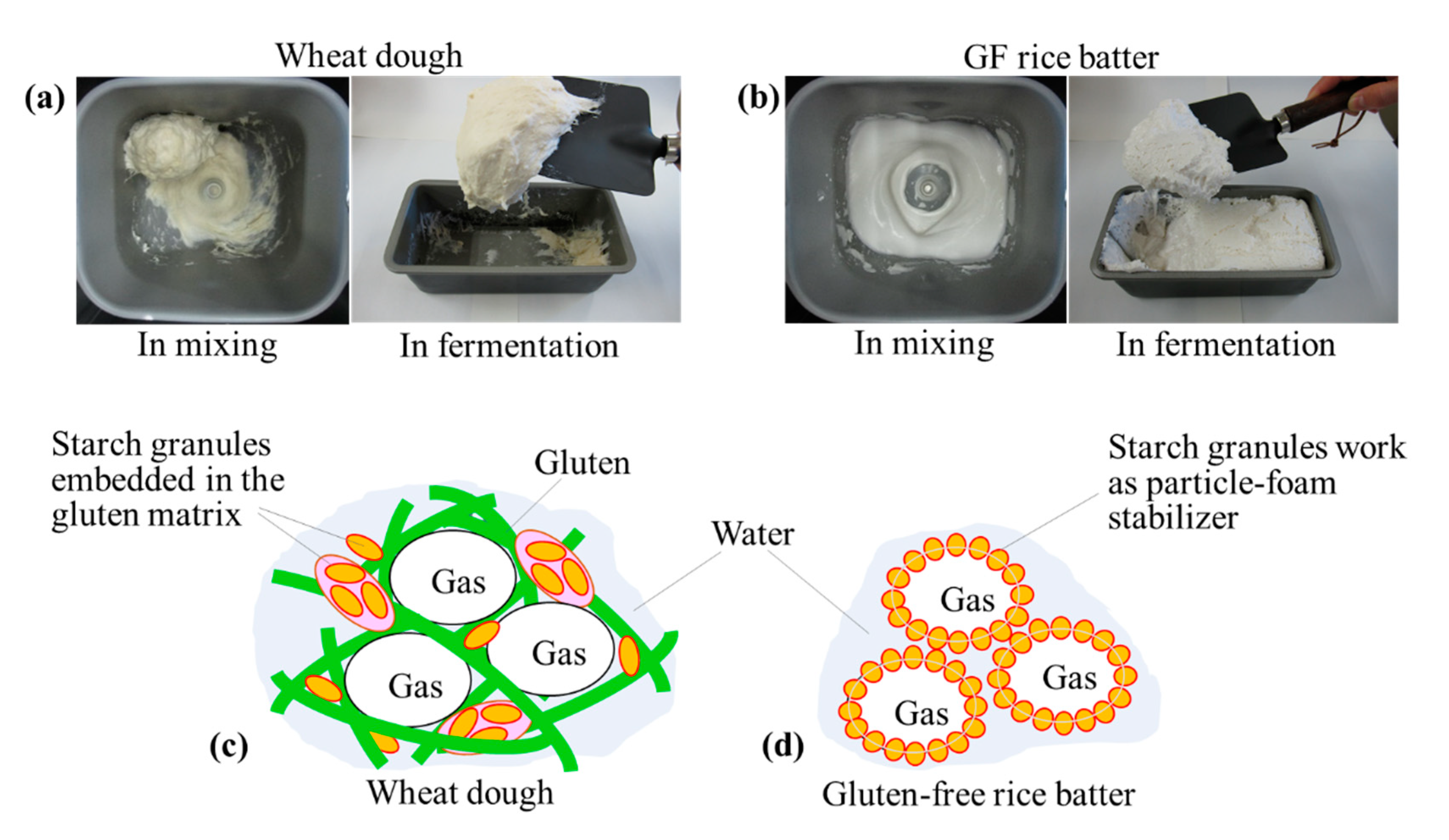
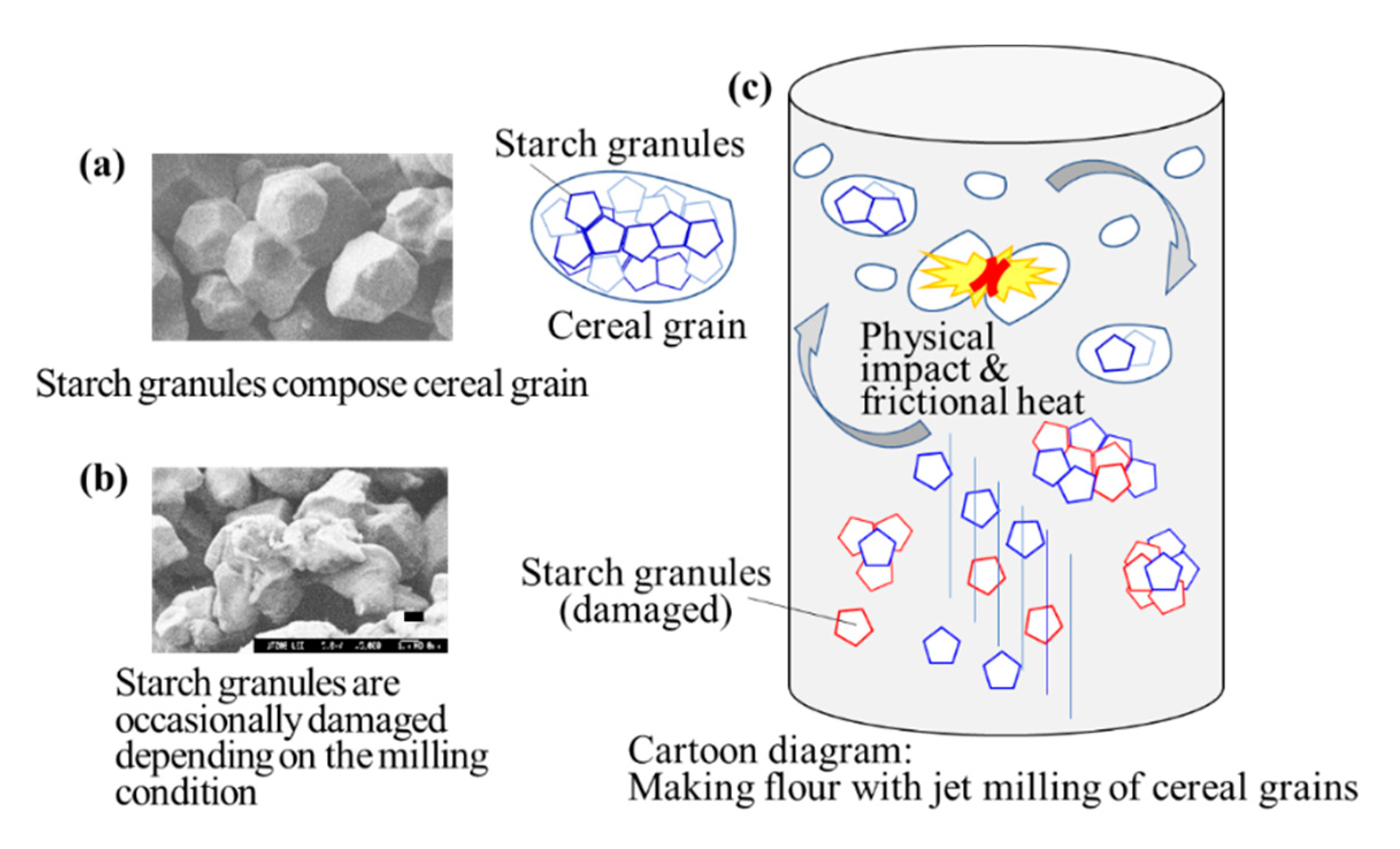

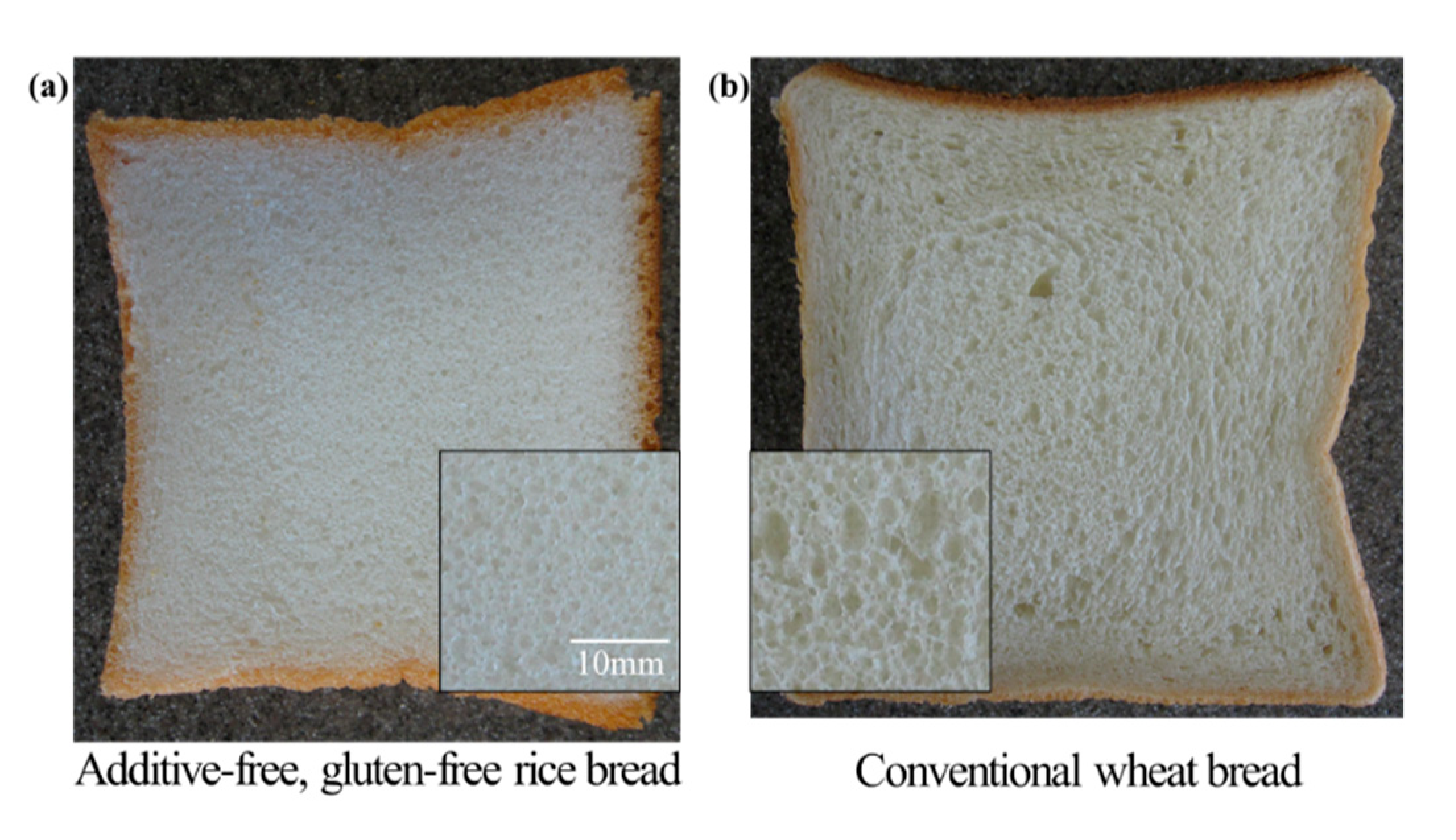

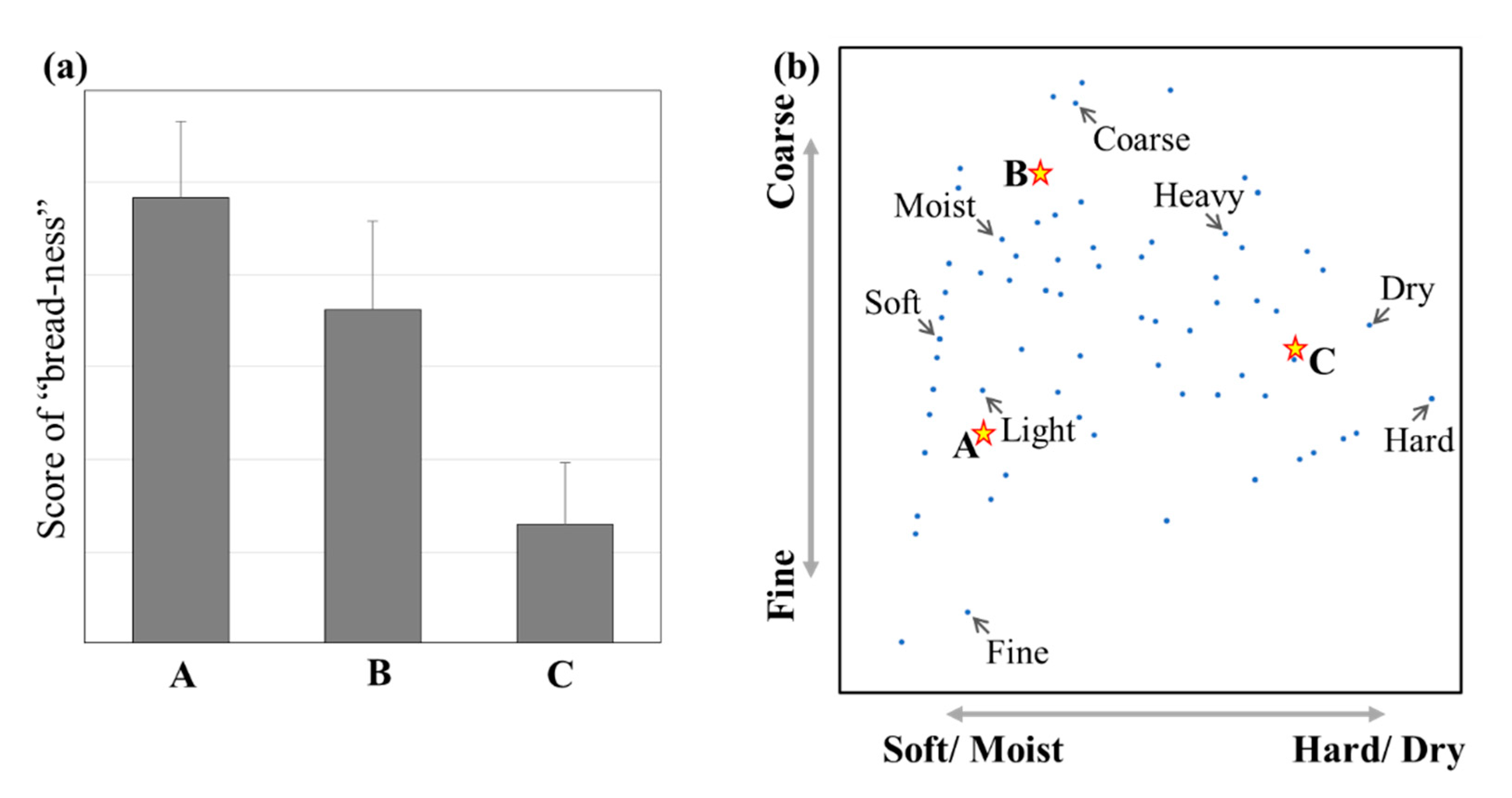
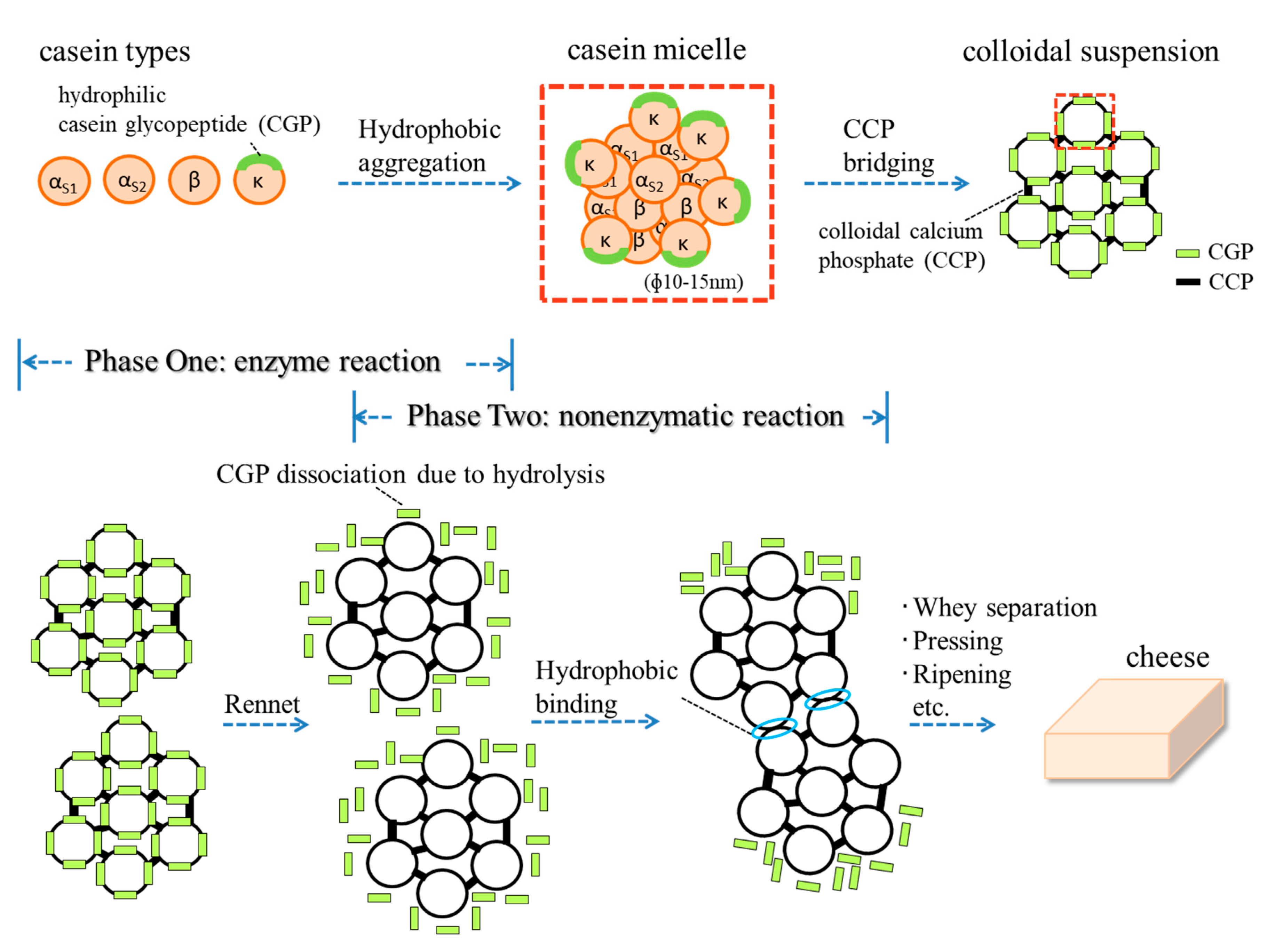
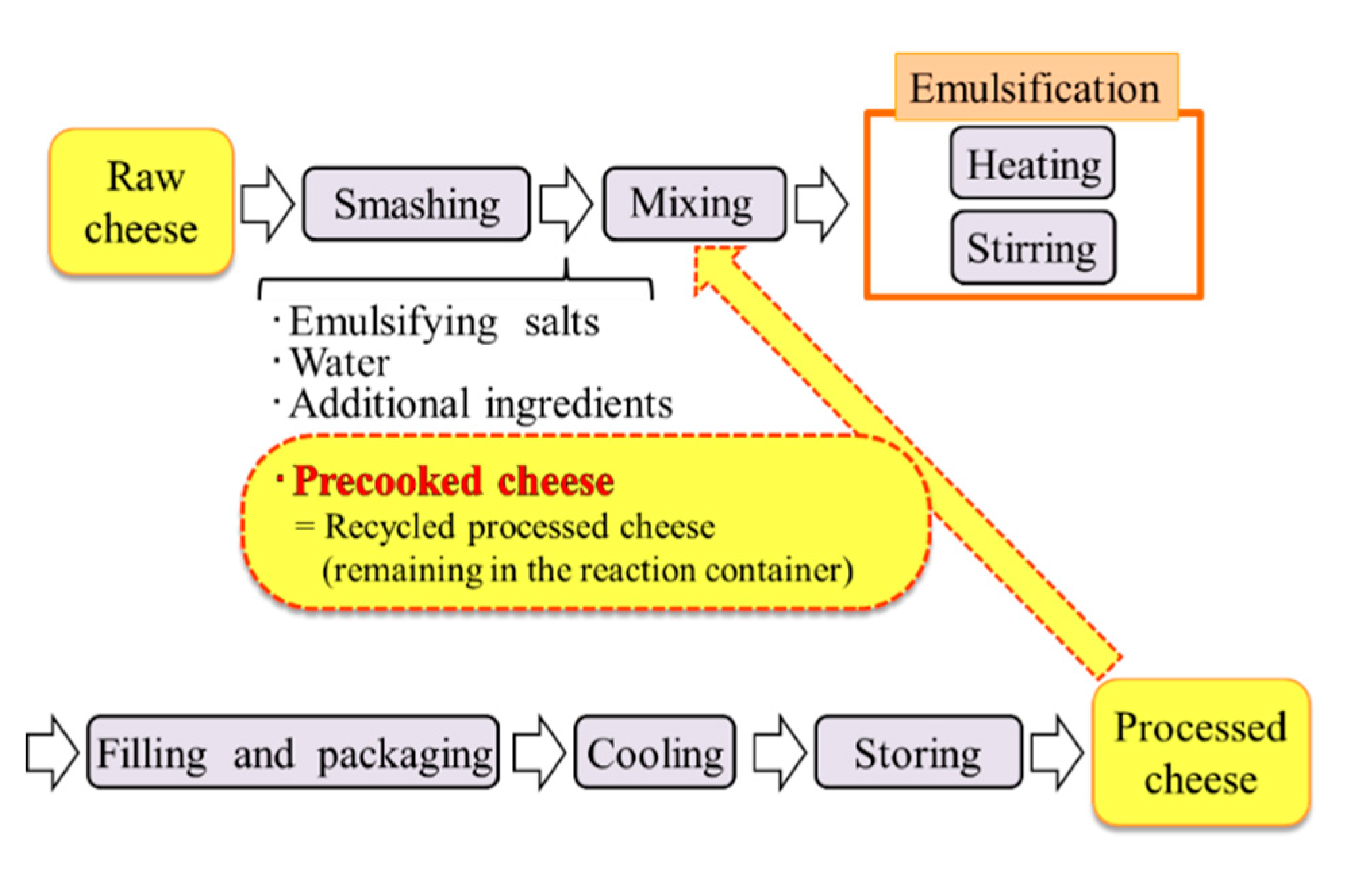
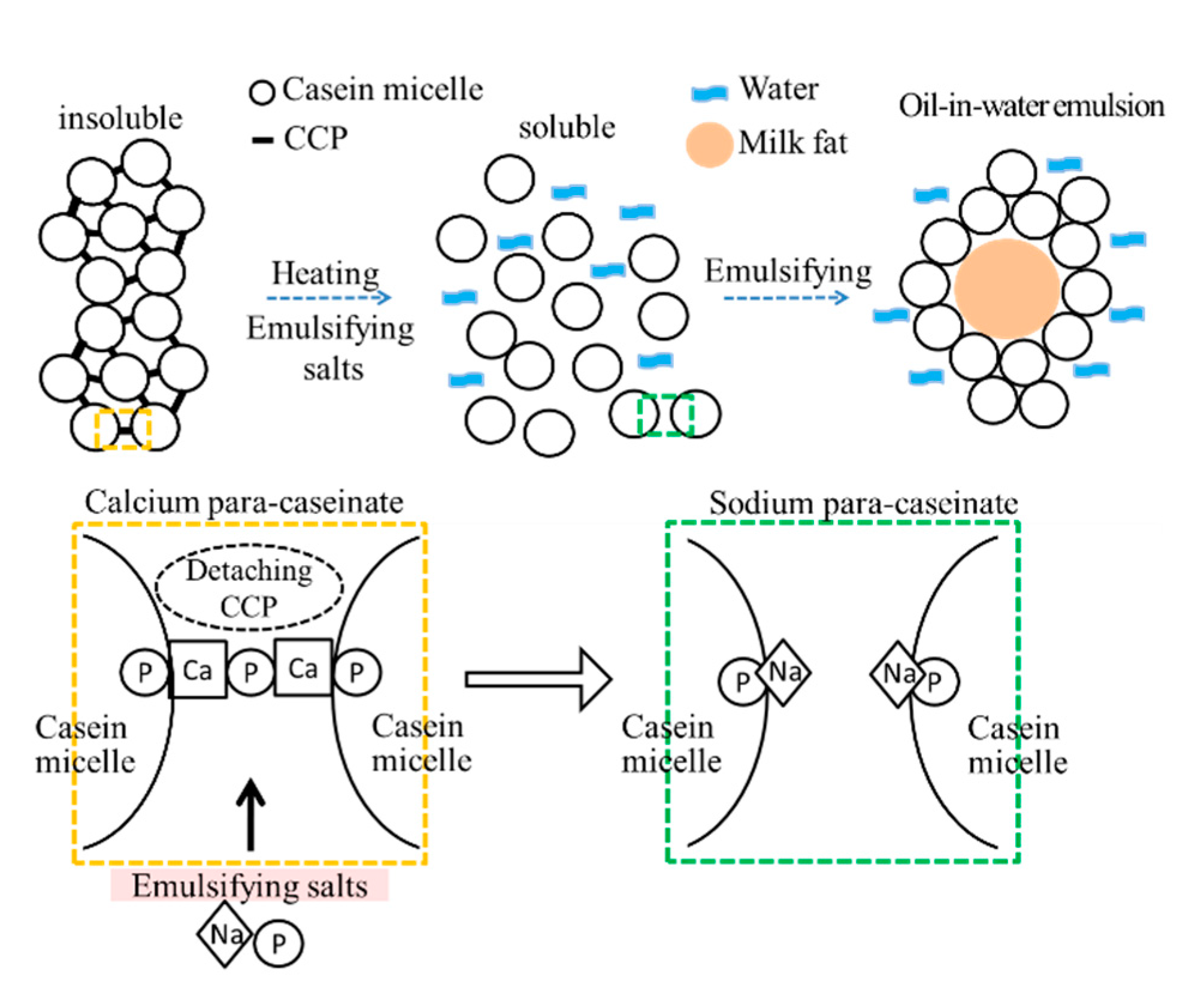


| Items. | Unit | Bread A | Bread B | Bread C |
|---|---|---|---|---|
| Water | g/100 g | 47.6 | 39.7 | 40.8 |
| Protein | g/100 g | 3.9 | 3.6 | 4.5 |
| Lipids | g/100 g | 1.5 | 5.6 | 4.9 |
| Ash | g/100 g | 0.9 | 1.3 | 1.0 |
| Carbohydrates | g/100 g | 46.1 | 49.8 | 48.8 |
| Sugars | g/100 g | 45.2 | 48.0 | 48.0 |
| Fibers | g/100 g | 0.9 | 1.8 | 0.8 |
| Energy | kcal/100 g | 212 | 260 | 256 |
| Na | mg/100 g | 338 | 471 | 332 |
| Salt | g/100 g | 0.859 | 1.20 | 0.843 |
Publisher’s Note: MDPI stays neutral with regard to jurisdictional claims in published maps and institutional affiliations. |
© 2020 by the authors. Licensee MDPI, Basel, Switzerland. This article is an open access article distributed under the terms and conditions of the Creative Commons Attribution (CC BY) license (http://creativecommons.org/licenses/by/4.0/).
Share and Cite
Wei, F.; Yano, H. Development of “New” Bread and Cheese. Processes 2020, 8, 1541. https://doi.org/10.3390/pr8121541
Wei F, Yano H. Development of “New” Bread and Cheese. Processes. 2020; 8(12):1541. https://doi.org/10.3390/pr8121541
Chicago/Turabian StyleWei, Fu, and Hiroyuki Yano. 2020. "Development of “New” Bread and Cheese" Processes 8, no. 12: 1541. https://doi.org/10.3390/pr8121541
APA StyleWei, F., & Yano, H. (2020). Development of “New” Bread and Cheese. Processes, 8(12), 1541. https://doi.org/10.3390/pr8121541





